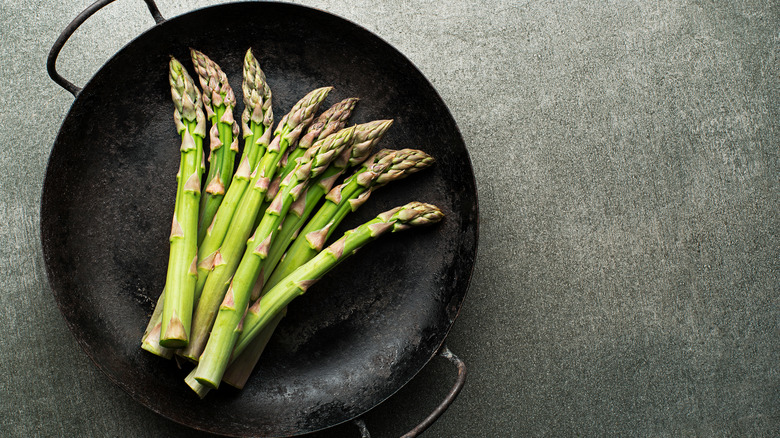Gordon Ramsay's Pro-Tip For Cooking Flavorful Asparagus Every Time
Chef and restaurateur Gordon Ramsay is full of priceless cooking tips — and he's got two more for everyone who loves cooking asparagus. First, he urges home cooks to stop boiling and steaming their asparagus because this sucks out all the flavor, leaving you with sad, wilted stalks. Asparagus cooked this way will quickly get you branded a muppet and kicked out of Hell's Kitchen.
Ramsay's second tip is to leave the skins on for the most flavor. While some claim that peeling asparagus will make it more tender, this decision often hinges on stalk size. Incidentally, Julia Child's tip for cooking thick and tender asparagus involves peeling the vegetable, something suggested by other cooks as well. For Ramsay's method, avoid the issue by looking for asparagus with medium-sized stalks, as these will have more flavor than super-thin ones and be less tough than super-thick ones.
The master chef demonstrates his cooking method in a video posted to the Gordon Ramsay Hell's Kitchen YouTube channel. In it, he shows how to sauté unpeeled asparagus over high heat until the skin blisters and the pan smokes, giving the stalks a bright green color with light charring. This technique is all about simplicity, so seasonings are kept to a minimum to enhance the vegetable's natural flavor, not overpower it.
Preparing and cooking asparagus the Gordon Ramsay way
Before you start cooking your asparagus, you have to remove the hard, woody ends you're not supposed to eat. To remove these, Gordon Ramsay has another tip: Use the knife to "feel for the asparagus," tapping along the stalk until it feels soft (via TikTok). When cutting, the knife should go through the asparagus smoothly, signaling you're removing the toughest bits. He removes roughly 2 inches from each stalk but urges folks not to throw away these pieces and instead use them to make stock for other dishes.
Once the asparagus is trimmed, Ramsay only seasons the stalks with salt and pepper before placing them evenly in a hot pan. Initially cooking the asparagus without any oil or butter is key to his method. Only when the pan begins to smoke does he add olive oil to help blister the skins. After cooking for less than a minute on each side, he turns the heat down and adds a little butter for extra richness. However, the real pièce de résistance is the fresh Parmesan and lemon zest — also a crucial component in Ramsay's avocado toast — which he grates over the top, giving the finished asparagus a decadent finish for a savory, bright vegetable dish.

